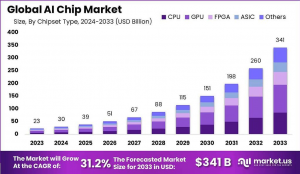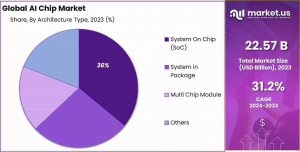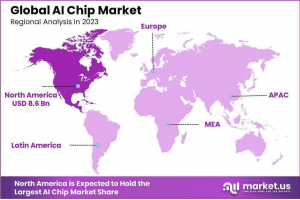AI Chip Market Grows Vastly Due to Top Companies Like NVIDIA, Intel, Qualcomm, Growth By USD 341 Billion by 2033
The Global AI Chip Market is projected to reach USD 341 Billion by 2033, growing from USD 23.0 Billion in 2023, at a CAGR of 31.2% from 2024 to 2033...
In 2023, North America held a dominant market position in the AI chip sector, capturing more than a 38% share of the global market...”
NEW YORK, NY, UNITED STATES, January 22, 2025 /EINPresswire.com/ -- The Global AI Chip Market is poised for substantial growth, with projections estimating it will reach USD 341 billion by 2033, up from USD 23.0 billion in 2023, reflecting a robust compound annual growth rate (CAGR) of 31.2% during the forecast period from 2024 to 2033.— Tajammul Pangarkar
Key factors driving this growth include the increasing adoption of AI across various industries, such as automotive, healthcare, finance, and consumer electronics. AI chips are critical for processing large volumes of data at high speeds, which is essential for powering AI algorithms in applications like autonomous vehicles, machine learning, natural language processing, and robotics.
Technological advancements in AI chip design, such as the development of specialized chips optimized for AI tasks, are further propelling market demand. Companies are focusing on creating more energy-efficient, high-performance chips to handle the growing demands of AI workloads. The shift toward edge computing, where AI processing is done closer to the data source, is also driving the need for more advanced AI chips.
Moreover, market trends indicate an increased focus on AI-driven innovations, fostering a competitive landscape among chip manufacturers. As industries continue to integrate AI solutions for automation and data-driven decision-making, the demand for AI chips will continue to grow, shaping the future of intelligent computing systems.
Key Statistics
The AI chip market is becoming an increasingly integral part of the global semiconductor industry. According to Deloitte's predictions, AI chips are expected to account for approximately 11% of the total global chip market in 2024, which is forecasted to be worth around USD 576 billion. This demonstrates the growing significance of AI chips as businesses across industries integrate artificial intelligence into their operations.
Venture funding for AI chip startups is also on the rise, with an expected increase from USD 15 billion in 2022 to over USD 20 billion in 2023. This upward trend reflects strong investor confidence in the growth potential of AI chips and their diverse applications. By 2024, funding is projected to exceed USD 25 billion, highlighting the market's continued expansion and innovation potential.
NVIDIA, a dominant player in the AI chip industry, reported impressive growth in 2023, with a revenue of USD 13.51 billion in Q2, reflecting a 101% year-over-year increase and an 88% surge from the previous quarter. This underscores the increasing demand for NVIDIA’s AI chips across industries. However, despite NVIDIA holding around 80% of the market share, companies like Advanced Micro Devices (AMD) are emerging as viable alternatives, fostering competition and driving further innovation in the market.
The adoption of AI accelerators, such as Graphics Processing Units (GPUs) and Field-Programmable Gate Arrays (FPGAs), is growing rapidly, particularly in data centers. By 2024, over 65% of data centers are expected to adopt AI accelerators, up from 45% in 2022. This trend highlights the increasing importance of AI in data processing and analysis.
Additionally, the number of patent applications related to AI chips is set to increase by 25% in 2023 and 20% in 2024, emphasizing the ongoing innovation and development of AI chip technologies. These trends indicate a strong future for the AI chip market, with expanding investment and innovation paving the way for further growth and competition.
Click Here To Get Research Sample @ https://market.us/report/ai-chip-market/request-sample/
Key Takeaways
— The AI Chip market is projected to reach an impressive USD 341 billion by 2033, growing at a robust Compound Annual Growth Rate (CAGR) of 31.2% during the forecast period.
— In 2023, the GPU segment led the market, securing over 32% of the total market share. Similarly, the System-on-chip (SoC) segment dominated with more than 36% of the market share in the same year.
— The Training segment was the largest, capturing over 65% of the AI chip market in 2023, highlighting the importance of AI model training. The Edge segment also had a significant share, holding more than 67% of the market, reflecting the growing need for real-time, localized data processing.
— In terms of industry applications, Consumer Electronics held a substantial portion of the market, contributing over 18% to the AI chip sector in 2023.
— Geographically, North America remained the dominant region, accounting for more than 38% of the global AI chip market share in 2023, driven by strong investments and technological advancements in the region.
Analysts’ Viewpoint
Government incentives and technological innovations are playing a pivotal role in accelerating the growth of the AI chip market. Many governments are offering subsidies, tax breaks, and funding for AI and semiconductor research, which is fostering innovation and driving the adoption of AI-powered technologies across industries. These incentives, coupled with continuous advancements in AI chip design, are creating a favorable environment for market expansion.
Investment opportunities in the AI chip market are abundant, with increasing venture capital funding flowing into startups focused on cutting-edge AI chip technologies. However, these investments come with risks, including high capital expenditure and long-term returns. Companies must balance the need for innovation with the market's competitive pressures and technological uncertainties.
Consumer awareness of AI applications is growing, which is driving demand for more advanced chips, particularly in sectors such as automotive, healthcare, and consumer electronics. Technological impacts, such as the rise of edge computing and AI accelerators, are further boosting the need for specialized AI chips that can support real-time data processing.
The regulatory environment is crucial in shaping the AI chip market's future. Governments are working to develop policies that address data privacy, security, and ethical considerations. Companies will need to stay compliant with evolving regulations to mitigate potential risks while capitalizing on growth opportunities in this rapidly developing market.
Get the Detailed Report at Exclusive Discount @ https://market.us/purchase-report/?report_id=115817
Report Segmentation
The AI chip market is segmented based on technology, application, and region to provide a detailed overview of market trends and growth opportunities. In terms of technology, the market includes GPUs (Graphics Processing Units), which are widely used for high-performance computing, particularly in AI model training and image recognition.
CPUs (Central Processing Units) are also evolving to handle AI tasks, while SoCs (Systems on Chips) integrate multiple components for AI processing in compact devices. FPGAs (Field-Programmable Gate Arrays) offer customizable hardware, ideal for specific AI workloads. The market is also divided by application, with AI chips used for training machine learning models, inference for running trained models in real-time, and edge computing for processing data locally, which reduces latency.
Consumer electronics, such as smartphones and smart devices, are significant end-users of AI chips. Furthermore, AI chips are deployed in industries like automotive for autonomous driving, healthcare for medical imaging and diagnostics, and industrial automation for robotics and predictive maintenance.
Regional segmentation includes North America, Europe, Asia-Pacific, Latin America, and the Middle East & Africa, providing insights into the geographical distribution of market demand and growth patterns. This segmentation helps identify specific drivers and opportunities across different regions and sectors.
Key Market Segments
By Chipset Type
— CPU
— GPU
— FPGA
— ASIC
— Others
By Architecture Type
— System On Chip (SoC)
— System in Package
— Multi Chip Module
— Others
By Function
— Training
— Inference
By Processing Type
— Edge
— Cloud
By Vertical
— Healthcare
— Manufacturing
— Automotive
— Retail & E-Commerce
— Media & Entertainment
— Consumer Electronics
— BFSI
— Others
Drivers:
The growth of the AI chip market is primarily driven by the increasing demand for AI applications across industries such as automotive, healthcare, and consumer electronics. As AI adoption grows, the need for powerful, efficient chips that can handle large volumes of data in real time becomes critical. Advances in AI chip technology, such as specialized chips for machine learning and deep learning models, are enhancing processing power while reducing energy consumption, further driving market growth. The widespread rollout of 5G networks is also a key driver, as it enables faster data transfer speeds and more reliable connections, boosting the need for edge computing and AI chips. Additionally, governments worldwide are investing in AI and semiconductor research, offering incentives and funding that accelerate the development of AI chips and their integration into industries.
Restraints:
Despite its growth potential, the AI chip market faces several restraints. High manufacturing costs associated with AI chips, especially in advanced technologies like GPUs and FPGAs, can hinder market expansion. The complexity of designing and producing AI chips also requires significant investment in research and development, which poses a financial challenge for smaller companies. Moreover, the global shortage of semiconductor materials has affected production and supply chains, leading to delays and increased prices.
Challenges:
The AI chip market faces challenges around data security and privacy, especially with the increasing use of edge computing and AI-powered devices. The rapid advancement of technology also creates a skills gap, with a shortage of professionals capable of developing and implementing AI chip solutions. Additionally, competition among major players, such as NVIDIA and AMD, intensifies the pressure for continuous innovation.
Opportunities:
The growing demand for AI in sectors like autonomous driving, healthcare, and smart cities presents significant opportunities for AI chip manufacturers. The rise of edge computing and AI accelerators further expands the market, as businesses look for localized data processing solutions. Investment in AI research and the development of specialized AI chips also offer avenues for innovation. Additionally, as consumer awareness of AI technology increases, demand for AI-powered devices in electronics, wearables, and home automation systems continues to rise, providing substantial growth potential for the market.
Key Player Analysis
The AI chip market is dominated by several major players, with companies like NVIDIA Corporation, Intel Corporation, and Advanced Micro Devices (AMD) leading the charge in both hardware development and innovation. NVIDIA is a market leader, holding a significant share, especially in the GPU segment. The company’s GPUs, designed for high-performance computing, are widely used in AI model training, deep learning, and autonomous vehicles. NVIDIA’s focus on enhancing its AI chip portfolio has solidified its dominance in the market.
Intel Corporation is another key player, known for its CPUs and specialized AI chips. Intel’s acquisition of Nervana Systems and its development of the Intel Nervana Neural Network Processor (NNP) have strengthened its position in the AI chip market. Intel is focusing on integrating AI capabilities into its processors to support a variety of industries, including healthcare and automotive.
AMD, known for its powerful processors and GPUs, is emerging as a strong competitor to NVIDIA, especially in the AI chip space. AMD’s products are gaining traction in both consumer electronics and data centers due to their efficiency and cost-effectiveness.
Other notable players in the market include Qualcomm, Google (with its Tensor Processing Units), and Apple, which have developed custom AI chips to support their AI-driven applications in mobile devices, cloud services, and autonomous systems. These companies are pushing the boundaries of AI chip technology, driving innovation and competition in the market.
Top Market Leaders
- NVIDIA Corporation (Mellanox Technologies)
- Intel Corporation
- Qualcomm Technologies Inc
- NXP Semiconductors
- Micron Technology
- Samsung Electronics Co Ltd,
- Advanced Micro Devices Inc.(Xilinx Inc.)
- Alphabet Inc.
- Apple Inc.
- Huawei Technologies
- MediaTek Inc.
- Other Key Players
Recent Developments
The AI chip market has seen significant advancements in both product innovations and strategic moves by key players. In 2023, NVIDIA Corporation unveiled its H100 Tensor Core GPU, designed for high-performance computing and AI workloads, delivering enhanced capabilities for machine learning and deep learning applications. This development further solidifies NVIDIA’s position as a leader in the AI chip market. Additionally, NVIDIA’s acquisition of Arm Holdings is expected to bolster its AI chip portfolio, enabling it to tap into new markets and create more specialized, energy-efficient chips.
Intel Corporation has made substantial strides by launching its Xe GPU line, aimed at data centers and AI workloads. The company also continues to focus on its AI accelerators and the integration of AI technologies into its chipsets, providing advanced capabilities for AI-driven industries such as autonomous vehicles and healthcare.
In 2023, AMD introduced its MI300 AI accelerator for data centers, designed to boost the performance of AI and machine learning models. The product is gaining traction for its energy-efficient design and high-performance capabilities, offering strong competition to NVIDIA.
Meanwhile, Qualcomm introduced its Snapdragon X Elite AI chip, aimed at mobile and edge computing, which enables real-time AI processing for connected devices. This marks a significant move in the edge computing space, where AI-driven solutions are increasingly required.
These developments highlight the ongoing innovation in AI chip technology, with companies continuously enhancing performance and expanding their product offerings to meet the growing demand for AI-driven applications.
Conclusion
In conclusion, the AI chip market is poised for remarkable growth, driven by increasing demand for AI applications across various industries and advancements in chip technology. Companies like NVIDIA, Intel, and AMD are leading the charge, continuously innovating to meet the needs of machine learning, data processing, and edge computing.
While challenges such as high costs and competition persist, the market offers significant opportunities, particularly in sectors like automotive, healthcare, and consumer electronics. As AI adoption expands, the demand for powerful, energy-efficient AI chips will continue to shape the future of intelligent computing and drive industry growth.
Explore More Research Reports
Live Streaming Pay Per View Market - https://market.us/report/live-streaming-pay-per-view-market/
Taxi App Market - https://market.us/report/taxi-app-market/
E-Commerce Logistics Market - https://market.us/report/e-commerce-logistics-market/
Shooting and Gun Accessories Market - https://market.us/report/shooting-and-gun-accessories-market/
Quantum Networking Market - https://market.us/report/quantum-networking-market/
Lawrence John
Prudour
+91 91308 55334
Lawrence@prudour.com
Visit us on social media:
Facebook
LinkedIn
Legal Disclaimer:
EIN Presswire provides this news content "as is" without warranty of any kind. We do not accept any responsibility or liability for the accuracy, content, images, videos, licenses, completeness, legality, or reliability of the information contained in this article. If you have any complaints or copyright issues related to this article, kindly contact the author above.



